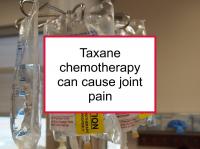Results of a prospective study indicate higher rates of muscle and joint pain than previously reported in breast cancer patients treated with taxane chemotherapy (docetaxel, paclitaxel, or (nab)-paclitaxel). Such symptoms persisted in a large proportion of patients up to one year after such treatment ended.
High pain scores and significant interference with many aspects of daily life were also reported. Compared to other side effects, both the prevalence and severity of muscle and joint symptoms in patients treated with taxanes have been poorly documented up until now.
The study included 275 patients with average age 53 who had not previously been treated with a taxane. The current analysis presents data for 95 of the enrolled participants; data collection is ongoing in the study. Patients completed a baseline questionnaire, as well as a diary on days 1 through 7 and on days 14 and 21 for three consecutive chemotherapy cycles. In addition, participants were interviewed by telephone on days 2 to 3 and days 5 to 7 following chemotherapy administration. The women subsequently were contacted at approximately three month intervals for one year. Half of the participants had early stage breast cancer upon enrollment, 35.34% had locally advanced disease, and 15.51% had stage IV disease.
A total of 41.4% of the participants reported muscle pain and 39.6% reported joint pain in their diaries during days 1 to 7. The legs, back, and arms were the most common sites of muscle pain. Joint pain was most often reported in the knees, ankles, and hips. The women most frequently described the pain as aching, tiring, nagging, exhausting, and tender. The pain was scored accordingly to a 1 to 10 scale of intensity. Of those who experienced pain during the seven days after treatment, the average rating for pain at its worst was 5.15 for muscle pain and 5.02 for joint pain. Muscle pain at its least had an average rating of 3.42 and joint pain at its least averaged 3.41. Pain scores tended to peak on day 5.
Participants who reported pain also had an average score of 5.39 for interference with basic activities in daily life. The scores were 4.86 for interference with mood, 5.5 for interference with working or housework, 4.12 for interference with relationships, 5.36 for interference with sleeping, and 5.44 for interference with enjoyment of life. A total of 27.2% of the women reported muscle pain one month after taxane treatment ended; the proportions were 31% after three months, 45.5% after six months, 37.2% after nine months, and 26.9% one year after taxane treatment had ended. The proportions reporting joint pain were 26% after one month, 38.1% after three months, 43.2% after six months, 48.8% after nine months, and 34.6% (9/26) one year after taxane treatment ended.
The authors plan to report on pain in relation to the taxane used, steroid tapering, role of anti-hormonal therapy, and impact of menopause on incidence of muscle and joint symptoms after all study data is collected and analyzed. They conclude that muscle and joint pain are common during taxane treatment and are significantly debilitating to the women who experience it.
Please see our article on breast cancer diet during paclitaxel chemotherapy for more information on how to optimize treatment with a taxane and reduce side effects.
